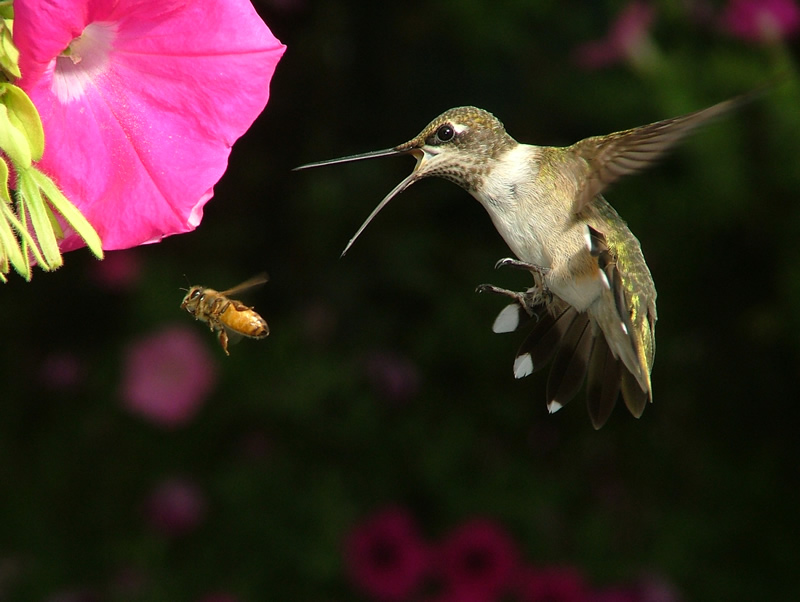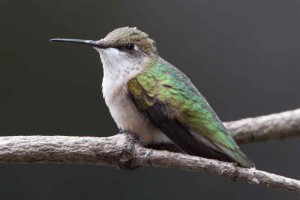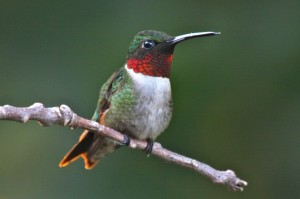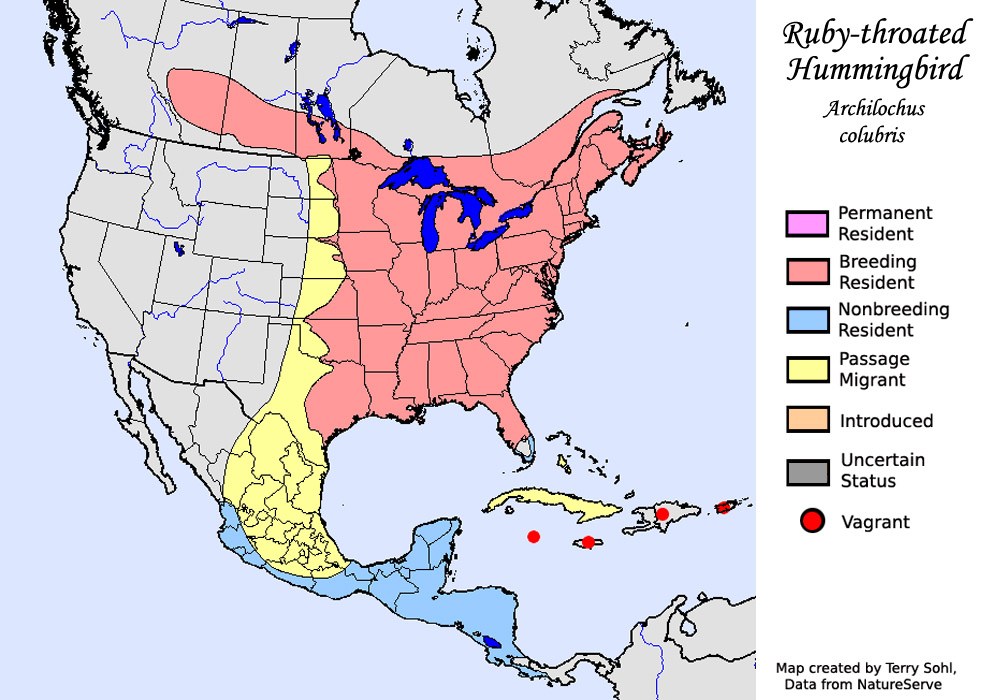IDENTIFICATION
The Ruby-throated Hummingbird is a small member of the Trochilidae hummingbird family (Robinson et al., 2013). The plumage of both sexes is light gray on the underside and iridescent green on the dorsal side and crown. Males, which are slightly smaller in size than females, have a black eye bar and a patch of brilliant red on the throat that gives the species its name (Robinson et al., 2013). The species is distinguished by a tiny body, long slender beak, long brown wings, and a short forked tail. During flight, its rapid wing movements create a humming sound and allow for rapid, agile movement.
HABITAT
The breeding range of the Ruby-throated hummingbird extends east of the Mississippi to the Atlantic coast, and from the Gulf of Mexico up to southern Canada. In the winter, the hummingbird migrates to southern Mexico and Central America (Sargent, 1999).
The Ruby-throated Hummingbird is the only hummingbird that breeds in the eastern United States (Sargent, 1999).
Ruby-throated Hummingbirds prefer woodland habitats, specifically mixed, deciduous, and pine forests in the summer, and tropical forests in the winter (Robinson et al., 2013). They exhibit flexibility in their habitat, as they can also populate scrub, marsh, open field, and man-made places such as gardens, orchards, and fencerows (Sargent, 1999).
FORAGING
Like most hummingbirds, the Ruby-throated Hummingbird uses its long tongue to extract nectar from wildflowers. The Ruby-throated Hummingbird shows preference for red tubular flowers. These flowers rely on hummingbirds for pollination and are thought to have coevolved with them (Robinson et al., 2013). The Ruby-throated Hummingbird’s migration patterns correlate to the blooming of its preferred flowers (Sargent, 1999).
As an omnivore, the Ruby-throated Hummingbird also feeds on insects, including mosquitoes, flies, and bees, and spiders and caterpillars (Sargent, 1999). It can unhinge its lower jaw to accommodate the size of the insects (Robinson et al., 2013).

The Ruby-throated Hummingbird feeds primarily on flower nectar and small insects (photo by: Stroud, 2005)
When nectar is scarce, the Ruby-throated Hummingbird feeds from sap wells created by Yellow-bellied Sapsuckers; they also frequent artificial bird feeders containing sugary water (Sargent, 1999).
SOCIAL BEHAVIOR
Ruby-throated Hummingbirds are territorial throughout the year, especially during the breeding season. Aside from mating, brooding, and territorial disputes, interactions between individuals rarely occur (Robinson et al., 2013).
Male Ruby-throated Hummingbird showing territorial behavior
The Ruby-throated Hummingbird spaces itself, depending on food availability, between 15 to 70 meters away from its neighbors. The male will occasionally defend his territorial integrity by beak-jabbing other males, but generally relies on vocalizations to establish boundaries (Robinson et al., 2013).
Communication between birds consists of chattering calls. Although the Ruby-throated Hummingbird is not a songbird, males will produce a series of chips at dawn. Complex calls during disputes, begging calls from chicks, and mating calls during the breeding season comprise the Ruby-throated Hummingbird’s repertoire (Robinson et al., 2013).
BREEDING BEHAVIOR
During the breeding season, mates locate each other with short mating calls. The Ruby-throated Hummingbird does not pair with its mate, and both sexes are polygamous from year to year (Robinson et al., 2013).
The male Ruby-throated Hummingbird’s courtship display consists of flying back and forth in a broad arc in front of the female while displaying his red feathers and producing an unusually loud hum (Bent, 1940).
The female Ruby-throated Hummingbird constructs its nest about 6 meters above ground on a tree branch or similar structure. Mosses, ferns, thistles,down, and young leaves are incorporated into the nest, which is mounted with spider webs and pine resin (Sargent, 1999).
Each egg clutch consists of two eggs, incubated by the female for two weeks. The mother Ruby-throated Hummingbird will feed her new chicks via regurgitation until they leave the nest at two to four weeks old (Bent, 1940).
REFERENCES
Bent, A. C. 1940. Ruby-throated Hummingbird Archilochus colubris. Life Histories of Familiar North American Birds. Smithsonian Institution United States National Museum Bulletin 176: 332-352.
Robinson, T. R., Sargent, R. R., and Sargent, M. B. 2013. Ruby-throated Hummingbird. The Birds of North America Online 204.
Sargent, R. 1999. Ruby-throated Hummingbird (Archilochus colubris). United States Department of Agriculture. Fish and Wildlife Habitat Management Leaflet Number 14.
images:
Clark, J., Ruby-Throated Hummingbird nest [online image] Retrieved 7 April 2015 from http://ngm.nationalgeographic.com/ngm/photo-contest/2012/entries/183445/view/.
Magers, D., Ruby-Throated Hummingbird, male [online image] Retrieved 6 April 2015 from http://www.birdsandblooms.com/birding/bird-species/hummingbirds-swifts-and-swallows/ruby-throated-hummingbird/.
Northrup, T. (2015) Female Ruby Throated Hummingbird perched [online image] Retrieved 6 April 2105 from http://www.northrup.org/photos/ruby-throated-hummingbird/.
Sohl, T. L., Ruby-throated Hummingbird range map [online image] Retrieved 6 April 2015 from http://sdakotabirds.com/species/ruby_throated_hummingbird_info.htm.
Stroud, J. C. (2005) Ruby-throated hummingbird [online image] Retrieved 7 April 2015 from http://www.fs.fed.us/wildflowers/pollinators/pollinator-of-the-month/ruby-throated_hummingbird.shtml.





how long this bird can live?